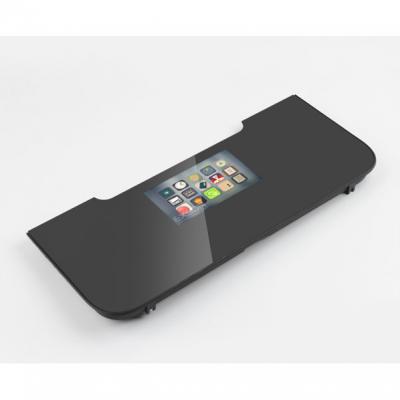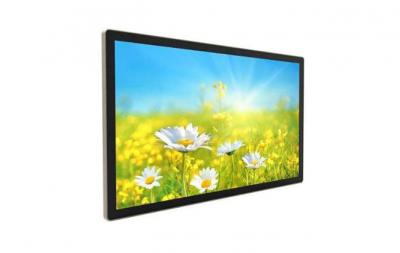The technology of LCD liquid crystal displays is developing rapidly, and LCD bar-type LCD screens are currently popular new products in the market. So what is a bar-type LCD screen?
An LCD bar-type LCD screen refers to a rectangular LCD screen with a length-to-width ratio greater than that of a regular LCD screen. It has a wide range of sizes and flexibility, high clarity, and is used in various fields such as commercial venues, public transportation, and corporate exhibition areas.
The bar-type LCD screen can be combined with the motherboard system and supports split-screen, simultaneous playback, terminal grouping management, account permission management, as well as multi-screen synchronization and linkage playback. Now let's introduce the characteristics and advantages of LCD bar-type LCD screens.
The bar-type LCD screens have been widely used in various scenes in our daily lives. They are widely used in public transportation systems such as airports, subways, and buses, in teaching fields such as multimedia teaching and campus auditoriums, in exhibition areas such as exhibition centers and multifunctional halls, and in commercial areas such as shopping centers, restaurants, and entertainment venues.
Bar-shaped LCD screens have a lot of considerations for environmental factors. For example, in public transportation systems, they need to have earthquake resistance and high temperature resistance. Therefore, bar-shaped screens need to have good reliability and stability.
Bar-shaped LCD screens generally use more robust and durable glass substrates and add fixed structures to the backlight module to achieve earthquake resistance. This enables bar-shaped screens to have the reliability that industrial-grade LCD screens have, meeting the requirements of working in various harsh environments.
Bar-shaped LCD screens generally use aluminum substrates, which improve the heat dissipation performance and slow down the fading of LED backlight modules. This minimizes the overall impact of the backlight source on the LCD module, achieving high energy efficiency and increasing the service life. At the same time, it also makes the overall module lighter and thinner.
We all know that the operating temperature of ordinary LCD screens is -20 to +70℃. However, bar-type LCD screens, according to the requirements of the environment, generally use screens with wide operating temperatures, which are -30℃ to +85℃.
This allows bar-type LCD screens to adapt to hotter or colder working environments and work outdoors at all temperatures. It meets the requirements of quick start and clear image display in low-temperature environments, as well as normal operation in high-temperature environments.
In some working environments of LCD bar-type LCD screens, brightness needs to be adjusted with changes in the environment. Therefore, some high-brightness bar-type LCD screens can be equipped with automatic light-sensitive control modules to adjust screen brightness based on environmental brightness. This allows the screen to achieve the best display brightness and improve the overall performance of the backlight module, extending its service life.
When bar-type LCD screens are used in commercial venues or corporate exhibition halls, they need to have excellent dynamic performance and high-definition color display. In this case, LCD bar-type LCD screens need to be equipped with IPS full-view angle display modules to have ultra-high dynamic performance, wider viewing angles, higher resolution and display contrast, more saturated color display, and faster response time. This enhances the overall visual performance of dynamic images.
The above are the characteristics and advantages of LCD bar-type LCD screens. Customers need to choose suitable bar-type LCD screens based on their own product application scenarios.
 The Role of Research and Development in TFT Module FactoryMay 9, 2024In the rapidly changing field of science and technology, TFT (thin film transistor) module factory not only faces the constant evolution of market demand, but also keeps up with the pace of technologi...view
The Role of Research and Development in TFT Module FactoryMay 9, 2024In the rapidly changing field of science and technology, TFT (thin film transistor) module factory not only faces the constant evolution of market demand, but also keeps up with the pace of technologi...view How Should the Liquid Crystal Panel Be Maintained Best?September 26, 2022With the popularization of LCD TVs, notebook computers, LCD monitors and other liquid crystal panels, the cleaning of liquid crystal panels has also become the focus of users' attention. Many user...view
How Should the Liquid Crystal Panel Be Maintained Best?September 26, 2022With the popularization of LCD TVs, notebook computers, LCD monitors and other liquid crystal panels, the cleaning of liquid crystal panels has also become the focus of users' attention. Many user...view The Advantages of Car LCD Modules in Modern VehiclesJanuary 25, 2024In today's fast-paced and technology-driven world, it's no surprise that even our vehicles are becoming smarter and more advanced. One of the key technologies that have revolutionized the auto...view
The Advantages of Car LCD Modules in Modern VehiclesJanuary 25, 2024In today's fast-paced and technology-driven world, it's no surprise that even our vehicles are becoming smarter and more advanced. One of the key technologies that have revolutionized the auto...view Navigating the Future: The Wonders of LCD Touch ScreensNovember 17, 2023In the ever-expanding landscape of interactive technology, LCD touch screens have become the unsung heroes, transforming the way we engage with our digital devices. From smartphones and tablets to int...view
Navigating the Future: The Wonders of LCD Touch ScreensNovember 17, 2023In the ever-expanding landscape of interactive technology, LCD touch screens have become the unsung heroes, transforming the way we engage with our digital devices. From smartphones and tablets to int...view Exson Tech LCD 128x160: Compact and High-Definition, the New Trend in Future DisplaysJuly 1, 2024In the wave of the digital age, the display screen, as the core component of human-computer interaction, directly affects the user experience with its performance and quality. Among numerous display b...view
Exson Tech LCD 128x160: Compact and High-Definition, the New Trend in Future DisplaysJuly 1, 2024In the wave of the digital age, the display screen, as the core component of human-computer interaction, directly affects the user experience with its performance and quality. Among numerous display b...view Features and Working Principle of a Resistive LCDAugust 13, 2024Resistive LCD is an inductive liquid crystal display device capable of receiving input signals from contacts and other inputs. The resistive LCD locates the touch point through the pressure difference...view
Features and Working Principle of a Resistive LCDAugust 13, 2024Resistive LCD is an inductive liquid crystal display device capable of receiving input signals from contacts and other inputs. The resistive LCD locates the touch point through the pressure difference...view Call us on:
Call us on:  Email Us:
Email Us:  2F-M1 XiaWei Industrial Park, GuanLan, LongHua District, SZ, China
2F-M1 XiaWei Industrial Park, GuanLan, LongHua District, SZ, China